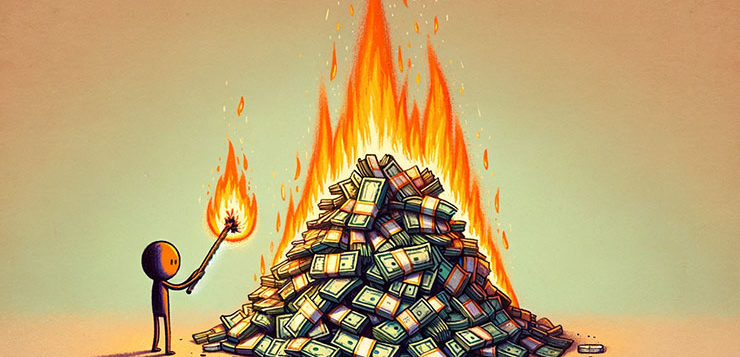The way to bring down prices in Australia is to punish consumers. Apparently. As for record corporate profits, that’s got nothing to do with our economic woes. Also apparently. Dr Dustin Halse wonders out loud whether the Reserve Bank has got it right on inflation?
Following the first meeting of the re-jigged Reserve Bank of Australia, the Bank’s approach to inflation is unchanged. High inflation, we are told, is predominantly a result of consumers with excess money driving demand rather than corporate pricing strategies – not to mention price gouging.
In sum: it’s your fault. You’re spending too much money.
While we have and will dispute this theory, the good news is that the likelihood of further interest rate hikes over the short to medium term appears low. Inflation, still outside the target band of 2-3 per cent, has fallen to 4.1 per cent, and most analysts are now pricing in an August 2024 interest rate cut.
Even so, Governor Michelle Bullock – recently appointed to lead the RBA after the awkward axing of her predecessor, Dr Phillip Lowe – is publicly preaching caution. When asked at her first RBA media conference ‘on a scale of one to ten, how confident are you that inflation is moving sustainably back to the target range?’ she responded: ‘Five’.
More alarming and mostly lost in the post-press conference coverage is the Bank’s entrenched economic thinking and uniform messaging. The RBA believes that higher interest rates should remain the dominant mechanism to lower inflation. According to the latest monetary policy statement, ‘Demand’ in the Australian economy ‘is still greater than supply’.
This may be an innocuous and measured comment upon first read, but it signals a highly contested approach to monetary policy.
As Greg Jericho, Chief Economist at the Centre for Future Work, put it: “Excuse me. Demand is greater than supply? By what measure?” He hits the nail on the head.
To contend that demand-side pressures are driving inflation assumes that household disposable income is increasing or that supply chain constraints are causing scarcity of products and leading to increased market bidding. Bottlenecks that emerged through the COVID-19 pandemic and the Ukraine-Russia conflict have now largely disappeared, and the supply of produce to consumers in the domestic agricultural market is strong.
Could the RBA be more cognisant of its limited capacity to tackle inflation? If its primary tool to lower inflation (raising the cash rate) is not effective, what is the role of monetary policy in ensuring the stated aims of ‘full employment, and the economic prosperity and welfare of the Australian people’?
More likely is the alternate belief (and one perennially articulated by central banks worldwide) that higher interest rates should be the primary tool to lower inflation. Yet international evidence to support this assumption is loose. Economists from the University of Portsmouth recently argued that central banks raise rates to mirror counterparts in other jurisdictions and increase investor bond yields; the effect of groupthink is powerful.
Another conclusion to draw is that the RBA believes workers have too much disposable income at hand and are driving demand through purchasing trends. This wage-price spiral theory is historic thinking in economics and clearly still informs the RBA’s analysis.
But again, if we look at the data, Australian workers have experienced a 4.5 per cent decrease in real wages since 2019, based on the RBA’s figures. The injection of cash into the Australian economy during the first phase of the COVID-19 pandemic was exhausted by households almost as quickly as it was received. Since the middle of 2021, wage growth has plummeted.
We consistently fail to hear about the role of company profit and price setting in driving inflation and cost of living pressures. The final report of the Inquiry into Price Gouging and Unfair Pricing Practices led by Professor Allan Fels (former ACCC Chair) notes that while there is much discussion about the role of monetary policy in fighting inflation, there is “hardly any discussion that looks at the actual prices charged to consumers… profit margins and their possible contribution to inflation”.
If we look at the price movements and margins in two sectors – Banking and Specialist Medical Care – we see the clear effect of monopolistic practices and an absence of genuine competition, let alone appropriate regulation. The ‘Big Four’ banks have all recorded multi-billion-dollar profits and increased their margins as the RBA has raised rates, and the out-of-pocket costs to see a Medical Specialist have increased by 50 per cent in 10 years. It is estimated that 500,000 Australians have foregone essential medical treatment because of charges being prohibitively high.
Currently, more attention needs to be focused on the role of prices in the market and how anti-competitive monopoly power often has had a detrimental impact on the economic well-being of Australians. The RBA would do well to fully encapsulate the function of corporate price-setting and price-gouging when considering its approach to interest rates and monetary policy.
Raising or keeping interest rates at an elevated level for a prolonged period may have little impact on inflation and instead exacerbate the cost-of-living pressures. Australian households deserve a break.
Donate To New Matilda
New Matilda is a small, independent media outlet. We survive through reader contributions, and never losing a lawsuit. If you got something from this article, giving something back helps us to continue speaking truth to power. Every little bit counts.




